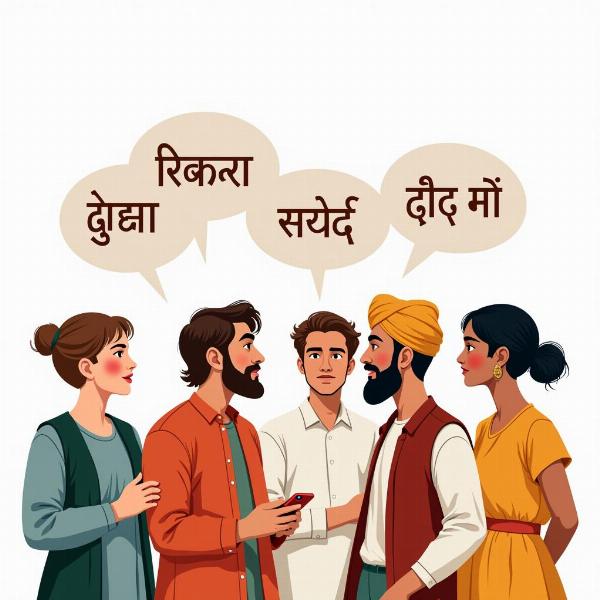Crafting meaning in Hindi requires a deep understanding of not only the language’s vocabulary and grammar, but also its rich cultural context. This intricate interplay of words, grammar, and cultural nuances is what truly breathes life into Hindi communication, distinguishing a simple translation from a truly meaningful interpretation. Whether you’re translating a business document, a legal text, or a piece of literature, capturing the essence of the original message in Hindi is paramount.
Unlocking the Essence of “Crafting Meaning in Hindi”
Understanding the user intent behind the search term “crafting meaning in Hindi” is crucial. Users are likely seeking more than just a word-for-word translation. They want to understand how to convey ideas, emotions, and intentions accurately and effectively in Hindi. This involves grasping the subtle shades of meaning embedded within the language and its cultural backdrop. A successful translation doesn’t just transfer words; it transfers meaning.
The Importance of Cultural Context in Hindi Translation
The rich tapestry of Indian culture significantly influences the Hindi language. Religious beliefs, social customs, and historical narratives all leave their mark on the way meaning is constructed and interpreted in Hindi. Consider the diverse dialects across India, each with its own unique vocabulary and expressions. Ignoring these cultural nuances can lead to misinterpretations and even unintended offense.
 Understanding the Cultural Context in Hindi Translation
Understanding the Cultural Context in Hindi Translation
Navigating the Complexities of Hindi Grammar
Hindi grammar, with its complex verb conjugations, gendered nouns, and intricate sentence structures, presents a unique challenge for translators. Mastering these grammatical intricacies is essential for crafting accurate and fluent Hindi text. A misplaced verb ending or an incorrect gender agreement can significantly alter the intended meaning.
Beyond Words: Exploring the Power of Idioms and Proverbs
Hindi is replete with idioms and proverbs that add color and depth to the language. These expressions, often rooted in cultural and historical narratives, can be challenging to translate literally. Understanding their figurative meanings and cultural significance is crucial for conveying the intended message accurately. For instance, the proverb “Khoda pahad nikli chuhiya” (literally, “dug a mountain, gave birth to a mouse”) doesn’t refer to rodents and mountains; it signifies a great effort yielding a meager result.
From Literal Translation to Meaningful Interpretation
Moving beyond literal translation requires a deep understanding of the target audience and the purpose of the text. Are you translating a technical manual, a marketing campaign, or a literary masterpiece? Each genre demands a different approach to crafting meaning in Hindi.
The Art of Adaptation in Hindi Translation
Sometimes, direct translation simply isn’t possible. Cultural differences, linguistic nuances, and target audience considerations may require adaptation. This involves creatively conveying the original message while remaining faithful to its essence. It’s a delicate balancing act that requires linguistic expertise and cultural sensitivity.
Conclusion: Achieving True Fluency in Crafting Meaning in Hindi
Crafting meaning in Hindi is a multifaceted process that demands more than just linguistic proficiency. It requires a deep appreciation for the language’s cultural context, grammatical intricacies, and idiomatic richness. By embracing these nuances, translators can move beyond mere words and create truly meaningful Hindi communication. Whether you’re slogan writing meaning in hindi or translating complex legal documents, understanding the nuances of Hindi is essential for crafting impactful and culturally relevant communication.
FAQ
- What is the difference between translation and interpretation? Translation focuses on written text, while interpretation deals with spoken language. Both require conveying meaning accurately, but the mediums and skills involved differ.
- How can I improve my Hindi translation skills? Immerse yourself in the language, study grammar, learn idioms and proverbs, and practice regularly. Concocting meaning in hindi involves continuous learning and refinement.
- Why is cultural context important in Hindi translation? Culture shapes language, and understanding cultural nuances prevents misinterpretations and ensures accurate communication. It allows for effective strategize meaning in hindi.
- What are some common mistakes to avoid in Hindi translation? Literal translations, ignoring grammatical gender, and misusing idioms are common pitfalls. Aim for nice caption meaning in hindi that resonates with the target audience.
- Where can I find professional Hindi translation services? Meaning-Hindi.in offers expert Hindi translation services across various domains.
Meaning-Hindi.in is your trusted partner for accurate and culturally sensitive Hindi translation services. We specialize in a wide range of translation services, from business and legal documents to technical manuals and website localization. Our team of expert linguists ensures that your message is conveyed effectively and resonates with your target audience. Contact us today at [email protected] or +91 11-4502-7584 for all your Hindi translation needs. Meaning-Hindi.in is committed to bridging the language gap and connecting you with your audience.